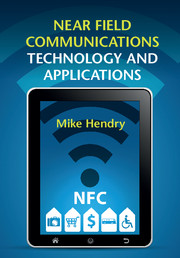Book contents
- Frontmatter
- Contents
- Part I Introduction
- Part II Technology
- Part III Applications
- 12 Marketing and advertising
- 13 Retail
- 14 Transportation
- 15 Payment
- 16 File- and device-sharing
- 17 Accessibility
- 18 Smart objects and the Internet of Things
- Part IV Implementation
- Appendix A Glossary
- Appendix B Standards
- Index
- References
18 - Smart objects and the Internet of Things
from Part III - Applications
Published online by Cambridge University Press: 05 December 2014
- Frontmatter
- Contents
- Part I Introduction
- Part II Technology
- Part III Applications
- 12 Marketing and advertising
- 13 Retail
- 14 Transportation
- 15 Payment
- 16 File- and device-sharing
- 17 Accessibility
- 18 Smart objects and the Internet of Things
- Part IV Implementation
- Appendix A Glossary
- Appendix B Standards
- Index
- References
Summary
Humans interact with things in their environment all the time. An increasing number of those interactions involve technology: a screen and keyboard, a mouse, accessing files in computer storage, analyzing data, etc. Often a human is needed just to facilitate an interaction between two objects: a person reads an identifier on an object and types it into a system in order to record the position or status of the object.
Smart objects can identify themselves to systems without human intervention. This implies some form of communication between the object and the system; this may be temporary, as when an RFID-tagged object passes a reader, or it may be longer lasting where the object is connected to a network. This is often known as machine-to-machine (M2M) communication, and leads to the concept of an Internet of Things (IoT), in which billions of objects have their own IP addresses and can connect freely to other objects and systems.
Most smart objects store, as well as a simple identifier, additional data about themselves: for example some history, a MAC address, or a URL link that gives access to these data. These data are used also by humans interacting with the object, so the IoT is often connected to the human-centric Internet.
A range of research studies (see, for example [1, 2]) has forecast that hundreds of billions of objects will be connected to the IoT by 2020, and that there will be a market of trillions of dollars to make it work.
- Type
- Chapter
- Information
- Near Field Communications Technology and Applications , pp. 216 - 232Publisher: Cambridge University PressPrint publication year: 2014



